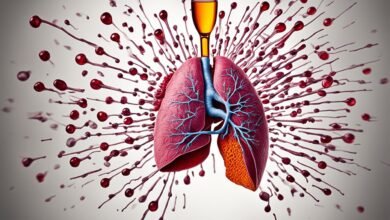Welcome to our informative article on the relationship between cholesterol LDL HDL and smoking. In this section, we will delve into how smoking impacts these cholesterol levels and the associated risks to your heart health. By understanding these risks, you can take proactive steps towards protecting your cardiovascular well-being.
Key Takeaways:
- Cholesterol LDL HDL levels play a crucial role in determining cardiovascular health.
- Smoking can disrupt the balance between LDL and HDL cholesterol, elevating LDL levels while decreasing HDL levels.
- Understanding the effects of smoking on cholesterol can help you make informed decisions regarding your lifestyle and health.
- Prioritizing cholesterol management, including smoking cessation, is essential for mitigating the risks associated with smoking and maintaining a healthy cholesterol profile.
- By quitting smoking, you can positively impact your cholesterol levels and overall cardiovascular well-being.
The Role of Cholesterol LDL HDL in Cardiovascular Health
In order to understand the impact of smoking on cholesterol levels, it is important to first grasp the significance of cholesterol LDL HDL in cardiovascular health. Cholesterol is a fatty substance that is naturally produced by the liver and can also be found in certain foods. It is crucial for the formation of cell membranes, the production of hormones, and the synthesis of Vitamin D. However, an imbalance in the levels of LDL (low-density lipoprotein) and HDL (high-density lipoprotein) cholesterol can contribute to the development of cardiovascular diseases.
Low-density lipoprotein (LDL) cholesterol, often referred to as “bad” cholesterol, transports cholesterol from the liver to the cells throughout the body. If LDL cholesterol levels become too high, it can lead to the build-up of plaque in the arteries, narrowing them and increasing the risk of heart disease.

Smoking has a detrimental effect on cholesterol levels and can disrupt the delicate balance between LDL and HDL cholesterol. Studies have shown that smoking increases LDL cholesterol levels while simultaneously decreasing HDL cholesterol levels, thereby exacerbating the risk of cardiovascular problems.
High-density lipoprotein (HDL) cholesterol, often referred to as “good” cholesterol, is responsible for removing excess cholesterol from the bloodstream and returning it to the liver for processing and elimination. Higher levels of HDL cholesterol are associated with a reduced risk of heart disease.
Smoking not only affects the levels of LDL and HDL cholesterol but also disrupts their functioning. It hinders the ability of HDL cholesterol to effectively remove excess cholesterol from the bloodstream, leading to a buildup of LDL cholesterol and an increased risk of cardiovascular problems.
Furthermore, smoking has been shown to cause oxidative stress and inflammation in the body, which can further contribute to the development of atherosclerosis and other cardiovascular conditions.
Understanding the role of cholesterol LDL HDL in cardiovascular health and how smoking impacts these levels is vital for comprehending the specific risks associated with smoking and cholesterol. By recognizing these factors, individuals can take proactive steps to manage their cholesterol levels and reduce the potential harm caused by smoking.
How Smoking Affects LDL and HDL Levels
When it comes to cholesterol, we often hear about the importance of maintaining a healthy balance between LDL (low-density lipoprotein) and HDL (high-density lipoprotein) cholesterol. However, what many people may not realize is that smoking can significantly disrupt this delicate balance.
Research has shown that smoking can have detrimental effects on both LDL and HDL cholesterol levels. Let’s take a closer look at how smoking impacts each of these cholesterol types:
Effect on LDL Cholesterol
Smoking has been found to raise LDL cholesterol levels, also known as “bad” cholesterol. The harmful chemicals in tobacco smoke can trigger inflammation in the walls of your arteries, leading to the buildup of fatty deposits. This buildup, also known as plaque, can narrow and harden your arteries, increasing the risk of heart disease and stroke.
Additionally, smoking can reduce the liver’s ability to clear LDL cholesterol from the bloodstream, further elevating LDL cholesterol levels. This increased LDL cholesterol and plaque formation can contribute to the development of atherosclerosis, a condition characterized by the narrowing and hardening of the arteries.
Effect on HDL Cholesterol
While smoking raises LDL cholesterol, it suppresses HDL cholesterol, which is often referred to as “good” cholesterol. HDL cholesterol plays a crucial role in removing excess cholesterol from your bloodstream and transporting it to the liver for disposal.
Smoking decreases the production of HDL cholesterol and impairs its functionality, making it less efficient in clearing LDL cholesterol. The reduction in HDL cholesterol levels can leave LDL cholesterol unchecked, allowing it to accumulate and contribute to artery blockages.
Smoking raises LDL cholesterol levels, also known as “bad” cholesterol, while suppressing HDL cholesterol, which is often referred to as “good” cholesterol. This imbalance can have serious implications for heart health.
This imbalance in LDL and HDL cholesterol levels is particularly concerning for smokers. Not only does smoking increase the risk of heart disease and stroke, but it also exacerbates the negative effects of elevated LDL cholesterol and reduced HDL cholesterol.
By understanding the impact of smoking on LDL and HDL cholesterol, we can appreciate why smoking is so detrimental to our cholesterol profile. Taking steps to quit smoking and adopting a heart-healthy lifestyle can help restore the balance between LDL and HDL cholesterol, reducing the risk of cardiovascular diseases.
| Effect of Smoking on Cholesterol Levels | LDL Cholesterol | HDL Cholesterol |
|---|---|---|
| Increased Levels | Smoking raises LDL cholesterol levels, which can contribute to plaque formation and atherosclerosis. | |
| Decreased Levels | Smoking suppresses HDL cholesterol levels, reducing its efficiency in clearing LDL cholesterol from the bloodstream. |
Reducing Dangers: Taking Care of Cholesterol and Quitting Smoking
In order to reduce the risks associated with smoking and cholesterol, it is essential to focus on cholesterol management and consider smoking cessation. By implementing effective strategies, individuals can work towards maintaining a healthy cholesterol profile and improving their overall cardiovascular health.
Cholesterol Management for Smokers
For smokers, managing cholesterol levels is of utmost importance. By making certain lifestyle changes and utilizing appropriate medications, individuals can effectively control their cholesterol and reduce the risks associated with smoking. These strategies include:
- Adopting a heart-healthy diet: Incorporating foods low in saturated fats and high in fiber, such as fruits, vegetables, and whole grains, can help improve cholesterol levels.
- Engaging in regular physical activity: Exercising regularly can increase HDL cholesterol, known as the “good” cholesterol, while also helping maintain a healthy weight.
- Taking prescribed medications: In some cases, healthcare professionals may recommend medications to manage cholesterol levels, especially for individuals at high risk of cardiovascular disease.
Smoking Cessation and Cholesterol Profile
Quitting smoking can have significant positive impacts on cholesterol levels and overall cardiovascular health. When individuals quit smoking, several changes occur within their bodies that contribute to an improved cholesterol profile:
- Increased HDL cholesterol: Within just a few months of quitting smoking, HDL cholesterol levels begin to rise, helping to reduce the risk of heart disease.
- Decreased LDL cholesterol: Quitting smoking also leads to a decrease in LDL cholesterol levels, the “bad” cholesterol that contributes to the formation of plaque in the arteries.
- Reduced inflammation: Smoking cessation reduces inflammation in the body, which is a key factor in the development of cardiovascular diseases.
By quitting smoking and managing cholesterol levels effectively, individuals can significantly reduce their risk of developing heart disease and other cardiovascular complications.
Conclusion
In conclusion, the relationship between cholesterol LDL HDL and smoking poses significant risks to your heart health. Smoking has been shown to have detrimental effects on cholesterol levels, with the potential to raise LDL cholesterol while reducing protective HDL cholesterol. These imbalances can increase your risk of developing cardiovascular diseases, such as heart attacks and strokes.
Understanding the effects of smoking on cholesterol is crucial for mitigating these risks. By prioritizing cholesterol management, including smoking cessation, you can take proactive steps towards maintaining a healthy cholesterol profile and promoting overall cardiovascular well-being. Implementing lifestyle changes, such as adopting a heart-healthy diet, engaging in regular physical activity, and managing stress, can also contribute to the improvement of your cholesterol levels.
It is important to consult with your healthcare provider for personalized guidance on cholesterol management strategies, as they can assess your individual risk factors and prescribe appropriate medications if necessary. Quitting smoking not only helps in reducing the harmful effects on your cholesterol profile but also has numerous other benefits for your overall health and well-being.
By integrating these steps into your lifestyle, you can significantly improve your cholesterol LDL HDL levels, reduce the risks associated with smoking and cholesterol, and enhance your cardiovascular health for the long term.
Read more : Lowering Cholesterol for a Heart
FAQ
What is the relationship between cholesterol LDL HDL and smoking?
Smoking can have detrimental effects on cholesterol levels, raising LDL cholesterol while lowering HDL cholesterol. This disrupts the balance between LDL and HDL, increasing the risk of cardiovascular diseases.
How does smoking impact LDL and HDL cholesterol levels?
Smoking has been shown to increase LDL cholesterol levels, which is commonly referred to as “bad” cholesterol. At the same time, smoking decreases HDL cholesterol levels, also known as “good” cholesterol. This imbalance can contribute to the development of atherosclerosis and increase the risk of heart disease.
Are cholesterol levels higher in smokers compared to non-smokers?
Yes, studies have shown that smokers tend to have higher total cholesterol levels, including elevated levels of LDL cholesterol. Additionally, smoking has been associated with lower levels of HDL cholesterol, which is responsible for removing excess cholesterol from the bloodstream.
How does smoking cessation impact cholesterol levels?
Quitting smoking can have significant benefits for cholesterol levels. Research has shown that within a few months of quitting smoking, HDL cholesterol levels can increase while LDL cholesterol levels decrease. This improvement in cholesterol profile contributes to a healthier cardiovascular system.
What can I do to manage my cholesterol levels as a smoker?
As a smoker, it is important to prioritize cholesterol management. This involves adopting a healthy lifestyle, including a balanced diet low in saturated and trans fats, regular exercise, and maintaining a healthy weight. Additionally, your healthcare provider may recommend medications, such as statins, to help manage cholesterol levels.
How does smoking impact cardiovascular health?
Smoking is a major risk factor for cardiovascular diseases, including heart attacks and strokes. Smoking damages blood vessels, reduces blood flow, increases blood pressure, and promotes the formation of blood clots. These factors, combined with the negative impact on cholesterol levels, greatly increase the risk of developing cardiovascular problems.



